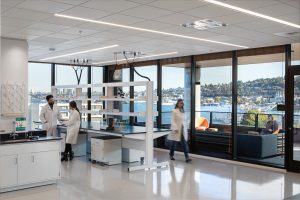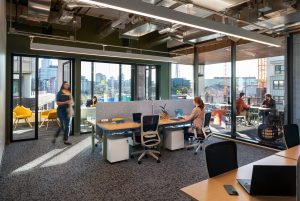Four Reasons to Kick Desks Out of Labs
Sara Vallerie, Ph.D., WELL AP, Fitwel Amb
 Do desks belong in labs? If you don’t live in the world of professional science, this question may seem inconsequential to you—why would it matter where the desks are if people can still do their work? However, the location of desks can significantly impact the lab staff’s ability to perform work safely and effectively. Desks should be moved out of labs and into offices for the four reasons I’ve outlined below.
Do desks belong in labs? If you don’t live in the world of professional science, this question may seem inconsequential to you—why would it matter where the desks are if people can still do their work? However, the location of desks can significantly impact the lab staff’s ability to perform work safely and effectively. Desks should be moved out of labs and into offices for the four reasons I’ve outlined below.
But first off—why should you listen to me? After fifteen years of working in labs, earning my Ph.D. in Biology, and completing two post-doctoral fellowships, I left the world of science to pursue my other passion: design. Ultimately, I merged the two pursuits and have since focused on studying the design of science. Since entering the design world, I’ve advocated for developing laboratories that better support their users. When I look at an existing lab, my first question is, “Where are the water bottles?” My follow-up question is, “Where are the desks?”
What’s the obsession with water bottles? Well, you can’t eat or drink in a lab; there is too great a chance of drinking out of the wrong container or getting a harmful chemical on your hands. Get any group of scientists together, and they will swap stories about people dying (or nearly dying) from eating or drinking in the lab; the Occupational Safety and Health Administration (OSHA) has prohibited food and beverages from being stored or consumed in the lab for this very reason.
When you visit a lab facility, you’ll typically find a collection of water bottles immediately outside the lab—often on a shelf, cart, or windowsill—but you’ll also find snacks and the occasional water bottle inside desk drawers. So why do people still do it if it’s so risky? The most obvious answer is convenience. While scientists and lab researchers generally don’t sit at their desks all day—or even for more than an hour—when they do, they want to be able to eat and drink. They don’t want to pack up their computer and move to a conference room or kitchenette to analyze data, perform documentation, or answer emails.
Reason #1: The health and safety of occupants
It’s not simply the risk incurred when someone is drinking in the lab; it also impacts access to water for the researchers who adhere to the rules. More time spent in the lab writing at your desk means less time with free access to water. Studies have shown that hydration can impact concentration, productivity, mood, and mental health. It’s been suggested that dehydration can cause an increase in errors equivalent to having a blood alcohol content of 0.08%. And for staff with medical conditions, such as pregnancy or kidney disease, the availability of water is critical to their health. By keeping desks in laboratories, we are reducing the ability of staff to hydrate, and consequently increasing the risk of costly errors as well as putting their health at risk.
 Reason #2: Impacts on collaboration
Reason #2: Impacts on collaboration
Desks are often located in a single row along a window, sitting back-to-back. This setup does not encourage conversation; furthermore, it keeps staff inside the lab, reducing opportunities for knowledge sharing across different labs and departments. When desks move into a shared or open office, it creates an area for collaboration beyond a single lab and fosters opportunities for people to overhear conversations and offer unexpected contributions. A recent study from MIT supports this idea: when researchers across disciplines were collocated in a new building, rates of collaboration and publication increased; the closer the researchers were located to one another, the higher their rate of collaboration was.
Reason #3: Lab air is expensive air
Laboratories require more costly air handling systems than a typical office. Labs use up to 3 to 4 times the energy of an equivalent office space, and 45-60% of the total energy consumed is attributable to the ventilation system. Our firm recently conducted a study to modernize labs at a large not-for-profit research facility and determined that 10% of lab space was used for desks. By placing desks in offices instead, we can significantly reduce the energy usage of a lab building.
Reason #4: It’s simply what people want
Based on my experience, providing staff with touchdown spaces within the laboratory, and a dedicated space outside the lab to decompress from the high-stress lab environment, is critical for mental health and productivity. When our firm has engaged lab users in planning exercises, the vast majority want to be able to eat and drink at their desks outside of the lab; in a poll I recently conducted on LinkedIn, 80% of respondents preferred this, as well.
In short, moving desks out of labs positively impacts safety, increases collaboration, reduces operational costs, and increases employee happiness, resulting in a better workplace—and a better workplace equals better results.